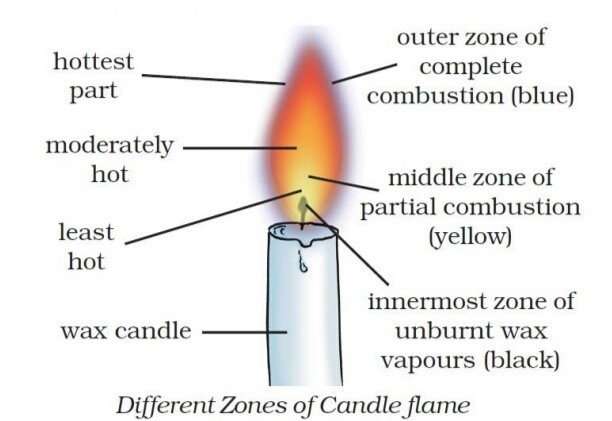Science
(www.olympiadsuccess.com)
Chapter 6: Combustion and Flame
Class: VIII
NCERT Solutions
Question 1
List conditions under which combustion can take place.
Answer 1
Conditions under which combustion can take place are as follows:
Question 2
Fill in the blanks:
(a) Burning of wood and coal causes __________ of air.
(b) A liquid fuel, used in homes is __________.
(c) Fuel must be heated to its __________ __________ before it starts burning.
(d) Fire produced by oil cannot be controlled by __________.
Answer 2
(a) Burning of wood and coal causes pollution of air.
(b) A liquid fuel, used in homes is Liquified Petroleum Gas (LPG).
(c) Fuel must be heated to its Ignition temperature before it starts burning.
(d) Fire produced by oil cannot be controlled by water.
Question 3
Explain how the use of CNG in automobiles has reduced pollution in our cities.
Answer 3
CNG produces very small amounts of harmful products like Sulphur dioxide, oxides of nitrogen, oxides of sulphur etc. CNG is a cleaner fuel.
Question 4
Compare LPG and wood as fuels.
Answer 4
|
Properties
|
LPG |
Wood |
|
1. Energy/unit mass 2. Pollution 3. Residue 4. Storage/Transport
|
Produces more energy Less pollution Leave no residue Easy to store & transport |
Produces less energy More pollution Leave ash as residue Need more space to store |
Question 5
Give reasons:
(a) Water is not used to control fires involving electrical equipment.
(b) LPG is a better domestic fuel than wood.
(c) Paper by itself catches fire easily whereas a piece of paper wrapped around an aluminium pipe does not.
Answer 5
(a) Water is not used to control fires involving electrical equipment because it may conduct electricity and harm those trying to douse the fire.
(b) LPG is a good fuel as compared to wood as it readily available and it is cheap. It burns easily in air at a moderate rate and it produces a large amount of heat. It does not leave behind any undesirable substances.
(c) Paper by itself catches fire easily whereas a piece of paper wrapped around an aluminium pipe does not because the ignition temperature of paper is low as compare to the paper wrapped around an aluminium pipe.
Question 6
Make a labelled diagram of a candle flame.
Answer 6

Question 7
Name the unit in which the calorific value of a fuel is expressed.
Answer 7
The calorific value of a fuel is expressed in a unit called kilojoule per kg (kJ/kg).
Question 8
Explain how CO2 is able to control fires.
Answer 8
CO2, being heavier than oxygen, covers the fire like a blanket. Since the contact between the fuel and oxygen is cut off, the fire is controlled.
Question 9
It is difficult to burn a heap of green leaves but dry leaves catch fire easily. Explain.
Answer 9
The ignition temperature of green leaves is higher than that of the dry leaves, so dry leaves catch fire easily.
Question 10
Which zone of a flame does a goldsmith use for melting gold and silver and why?
Answer 10
Goldsmith uses the outermost zone of the flame for melting gold and silver because it is the hottest zone (complete combustion) of the flame.
Question 11
In an experiment 4.5 kg of a fuel was completely burnt. The heat produced was measured to be 180,000 kJ. Calculate the calorific value of the fuel.
Answer 11
Calorific Value = Heat produced (in kj)
Mass of Fuel (in kg)
= 180,000 kj
4.5 kg
= 1800000
45
= 40000 kj/kg
Question 12
Can the process of rusting be called combustion? Discuss.
Answer 12
No, as rusting is a very slow process as compared to combustion and the heat evolve in combustion is much more than rusting. Rusting can take place at room temperature but combustion need an ignition temperature.
Question 13
Abida and Ramesh were doing an experiment in which water was to be heated in a beaker. Abida kept the beaker near the wick in the yellow part of the candle flame. Ramesh kept the beaker in the outermost part of the flame. Whose water will get heated in a shorter time?
Answer 13
The outermost part of the flame is the hottest one, so Rakesh’s water will get heated in a shorter time.
Yearlong program for Olympiads preparation & to build necessary skills for future.
Explore More
Time to mark your calendar with the upcoming Olympiads exam schedule.
Explore More
Take your Olympiad preparation to next-level by taking LIVE Classes.
Explore More
Assess your performance by taking topic-wise and full length mock tests.
Explore More
Online tuitions for international compeitions like SASMO, SEAMO, etc for Grades 1-11.
Explore More